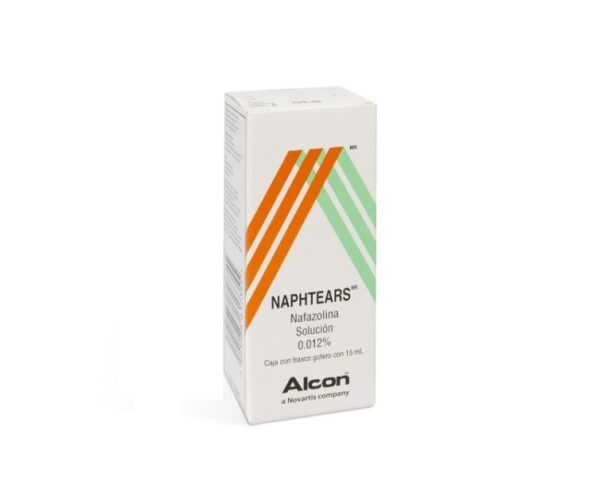Naphazoline is a medication used primarily as a decongestant to relieve redness, itching, and watering of the eyes due to minor eye irritations (e.g., smog, swimming, dust, or smoke). It belongs to a class of drugs known as sympathomimetic amines. Naphazoline works by narrowing the blood vessels in the eye, thereby reducing swelling and redness.
Naphazoline is a sympathomimetic drug used that causes vasoconstriction by activating the alpha-adrenergic receptors. It is used as a temporary treatment for the symptomatic treatment of redness, swelling, itching, and tearing associated with ocular allergies.
Naphazoline Dose in Adults
Naphazoline Dose in the treatment of Ocular redness and allergies:
- Put one or two drops in the affected eye(s) every 3 to 4 hours, or less often if needed.
- Make sure to follow these instructions carefully for the best results.
Naphazoline Dose in Children
Not recommended for use in children
Pregnancy Risk Factor: C
- It has not been studied in pregnancy and breastfeeding and is classified as category C during pregnancy.
Naphazoline Dose in Renal Disease:
- There are no specific dosage adjustments provided in the manufacturer's labeling for naphazoline in cases of kidney disease.
Naphazoline Dose in Liver Disease:
- The manufacturer's labeling for naphazoline does not include dosage adjustments for liver disease.
Severe side effects of naphazoline:
keratitis, ocular hypertension, coma, and bradycardia
Moderate side effects:
Hypertension, Blurred vision, Hyperglycemia, Respiratory depression, Hypotension, and Sinus tachycardia
Mild side effects:
Mydriasis, lacrimation, ocular irritation, hyperhidrosis, drowsiness, weakness, headache, dizziness, nausea, lethargy, vomiting, and hypothermia.
Contraindication to Naphazoline Include:
- If someone is allergic to naphazoline, antazoline, or any part of the medicine, or if they have glaucoma, they shouldn't use it.
- It's also not recommended for children unless a doctor advises it.
- If you're unsure about using it or have any concerns, it's best to talk to a doctor for guidance.
Warnings and Precautions
Cardiovascular disease
- If someone has heart problems or high blood pressure, they should be careful when using naphazoline because it can raise blood pressure due to its effects on the body
Diabetes:
- If someone has diabetes, they should use naphazoline cautiously.
- It's important because it can affect blood sugar levels, which is crucial for people managing diabetes.
Thyroid disease:
- For individuals with hyperthyroidism, it's important to be cautious when using naphazoline.
- This is because the medication can have effects on the body that may interact with the condition.
Monitoring Parameters:
Monitor for improvement or worsening of the symptoms.
How to administer Naphazoline?
- When using naphazoline eye drops, it's important to follow these steps for safe administration: First, wash your hands.
- Make sure not to touch the tip of the container to your eye to prevent contamination.
- If you wear contact lenses, remove them before using the eye drops.
- After putting in the drops, wait for a bit before putting your contact lenses back in.
- Also, don't insert your contacts if your eyes are still red.
- These precautions help ensure the effectiveness of the treatment and reduce the risk of irritation or infection.
Naphazoline Mechanism of action of Naphazoline:
- Naphazoline works by stimulating alpha-adrenergic receptors in the small blood vessels (arterioles) of the conjunctiva, which helps to narrow these blood vessels and reduce redness and swelling in the eyes.
- On the other hand, antazoline acts by inhibiting the effects of histamine on conjunctival epithelial cells.
- Histamine is a chemical released during allergic reactions, and its effects can include itching, redness, and swelling.
- By blocking histamine's effects, antazoline helps to alleviate these allergic symptoms in the eyes.
- Together, these mechanisms make naphazoline and antazoline combination eye drops effective in relieving eye redness and itching caused by various factors, including allergies.
Naphazoline international brands:
- Albalon-A
- Alergiftalmina
- Alergoftal
- Antistin-Privin
- Antistin-Privina
- Apihist
- Dermophenazol
- Midazol Ofteno
- Nazolin
- Noscam
- Ocured
- Oftalirio
- Oftophenazol
- Ophtazolin
- Orthophenazole
- Refresh Eye Allergy Relief
- Red Off Plus
- Rhinophenazol
- Sanorin-Analergin
- Sesal
- Zolinox
Naphazoline Brands in Pakistan
|
Naphazoline [Drops 0.012 %v/v] |
|
|
Naphtears |
Novartis Pharma (Pak) Ltd. |







